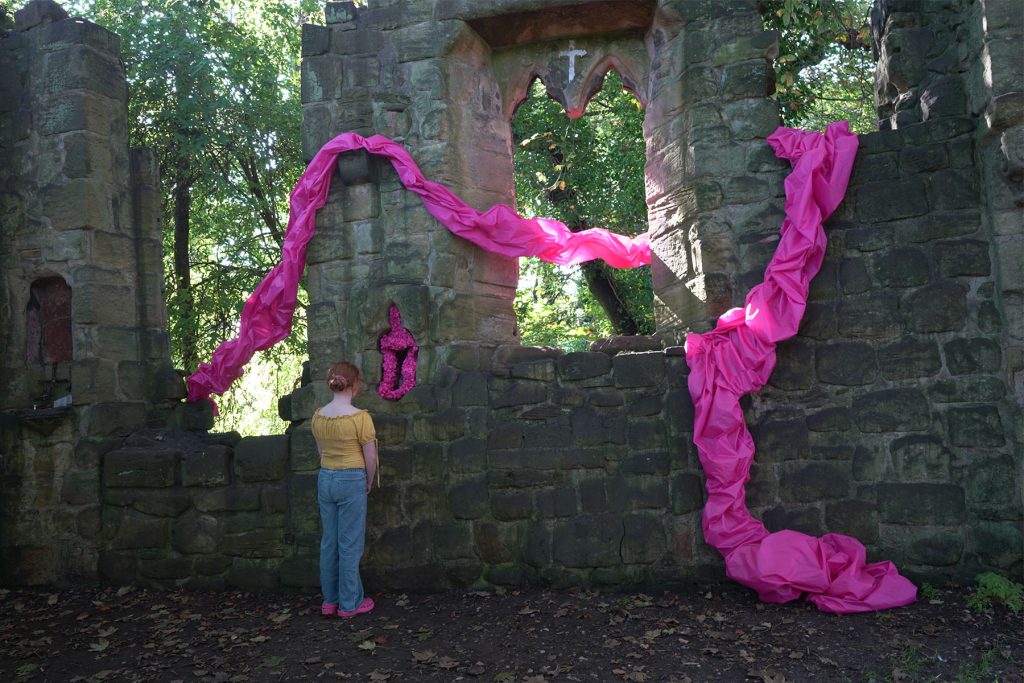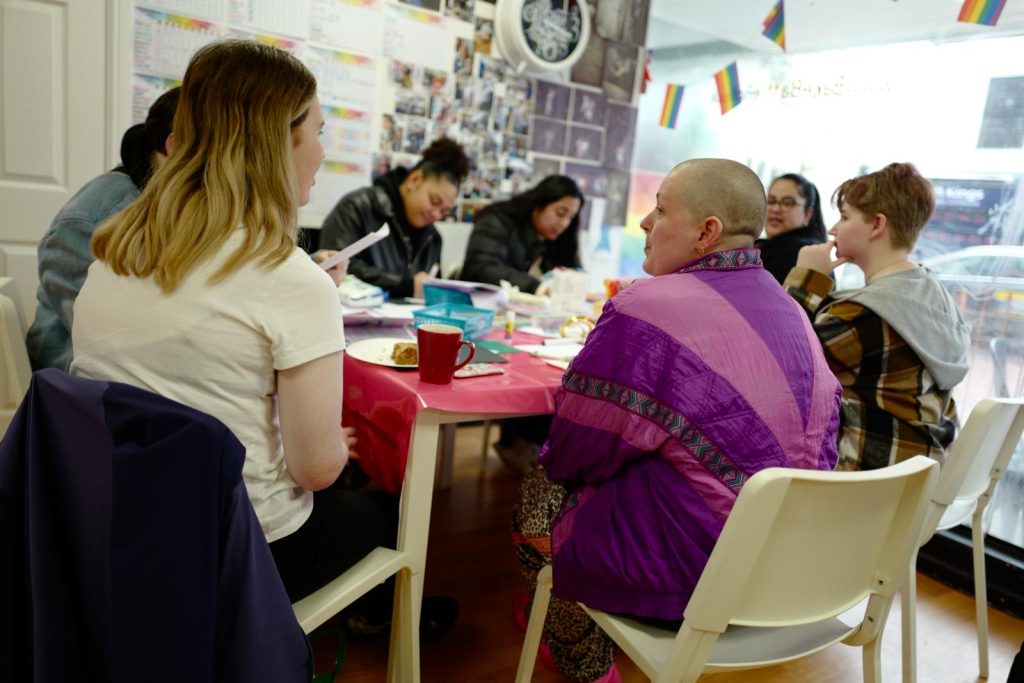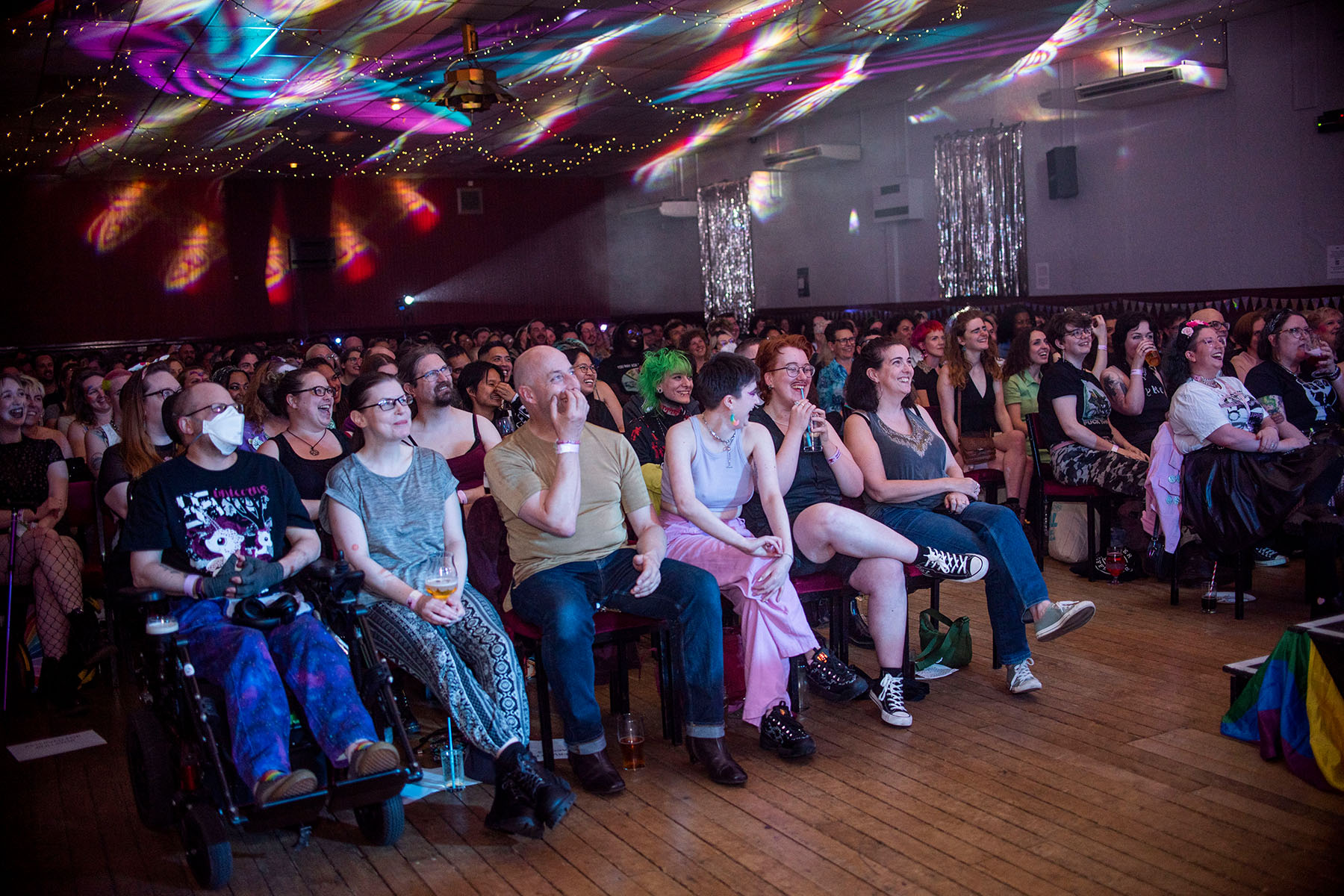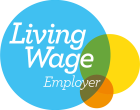As part of our longer term collaboration with Right Up Our Street we’ve been working in Doncaster since October 2023 on a project for the local LGBTQ+ community.
Right Up Our Street is a community-led Creative People and Places arts programme funded by Arts Council England. In 2023 Right Up Our Street’s Community Advisors suggested and voted for the Priority Community groups they wanted to see the programme work with. The LGBTQIA+ community was one of the three groups selected by them.
Working with Finn Warman, artistic director of Andro and Eve, the project has encouraged different generations to explore themes of Pride and what that means to them.
For the first phase of the project Finn facilitated creative writing workshops with LGBTQ+ people of all ages and their contributions were collated into a beautiful zine, Reyt Proud designed by Yorkshire based designer, Jazyra Christou. Read more about Jazyra in this Meet the Artist blog.

In the second phase of the project, artist Lady Kitt is making an installation, titled ‘Visible Rest’ to be shared at Doncaster Pride on 10 August. This work has been inspired by reflections, ideas and stories from LGBTQ+ people in Doncaster, in workshops facilitated by Kitt.
Ahead of Doncaster Pride on 10 August, we caught up with Lady Kitt to find out more about their work and artistic practice.
Can you tell us about your practice and any previous projects you’ve worked on?
Hia, I’m Kitt, I call the way I make art ‘Mess Making As Social Glue’, which probably says quite a bit about my practice, and my personality! I’m a Disabled sculptor & drag king. I work on long term, collaborative projects always driven by insatiable curiosity about how art can be useful. All my work is with other people in some way; I’m not an hours-alone-in-the-studio-solitary-kind of artist! I work most regularly on creative projects with my Newcastle based drag family DGA and my two children who are 9 and 12.

With DGA I’ve been working on a project since 2021 called Drag Declares Emergency. It started through a residency with the wonderful Craftspace in Birmingham. The project asks: How can LGBTQIA+ communities use our crafting skills to support the wellbeing of queer people and the health of planet Earth? Over the next few months we’re running workshops at Festival of Thrift (Billingham), MAC (Birmingham) and Queer Circle (London).
Me and my children have just collaborated on a commission from curator Sue Loughlin and The New Bridge Project to create a written, drawn and audio review of the exhibition MOTHEROTHER. The exhibition explores the relationship artist mothers have with themselves, their children, society, politics and the artworld- so we all had quite a lot to say about that! There is a link to the audio for MOTHEROTHER here for anyone who might be interested:
What inspires you as an artist?
All sorts of stuff! At the moment: Strictly Come Dancing, going swimming, Joe Lycette, shrines, professional mermaid / man / folk instagram accounts, learning more about The Levellers (political movement during the English Civil War, who campaigned for equality, religious tolerance & suffrage), my local LGBTQ+ Group “NSG”, my sister, my children.
My kids and I often work on commissions together. We also use art in our day to day lives to share enthusiasms and navigate complex emotions.. We use creativity and making to express and process our feelings, to connect and (most importantly) to make mischief together – all of which I find inspiring.

Physically, the shapes and textures of the fabric, rope and paper sculptures I make, reference Anglo-Saxon objects found in my home counties of Durham and Northumberland and scrunchies! The intricately woven patterns in things like the Lindisfarne Gospels and the Bamburgh Bird were created (in part) to provide protection from evil spirits. Objects using these tangle of forms were often placed around buildings to catch and confuse bad magic in their writhing mesh! When my sculptures are commissioned, I ask people I’m working with ‘which part of your event, space or work most needs protection or care?’ The answer often informs where the work goes.
Your work often involves large scale installations with recycled materials, how did this approach evolve?
I’ve always loved really massive, immersive installations- I’m a huge fan of contemporary installation artists like Joana Vasconcelos, Ramesh Nithiyendran and Jonathan Baldock, who really create distinct, immersive atmospheres with their work. And I’ve also always been absolutely obsessed with folk art celebrations and shrines. I got taken to lots of these as a child in Portugal.

Folk-art traditions and shrines have this amazing way of being maintained and developed over decades (even centuries sometimes) to fulfil a variety of functions for the communities who look after them. Shrines quite often invite votive offerings of handwritten prayers, devotional objects and bouquets, which is a tradition I really draw on in my own work- aways incorporating invitations for visitors or audiences to add to an installation over time.
I like the idea that a place isn’t just made by or for one person, but collectively conceived and preserved. I like that shrines provide somewhere to meditate on how individuals feel at a given point in their lives. They also offer an outlet for creative expression and emotional regulation by physically making things like ritual objects or flower arrangements. Folk practices, like Morris dancing, offer regular opportunities for communities to get together and be creative. As well as occasions for expression, these gatherings make time for emotional and practical support to be expressed, sought, and shared, a process I call ‘building creative intimacies’. To me, this is the same with queer cultural gatherings like Pride or regular local drag nights. I think of drag as a form of contemporary folk art.
Folk places, objects and ways of doing things are inevitably formed through, document, and support the lives of the people who create them. All this stuff is often referred to as ‘intangible’ heritage. For me, it is also ‘emotional heritage’. I’m interested in how I can collaborate with other people to create space for our queer emotional heritage to happen and to be documented, so a lot of my installations are about creating time and resources for people to experiment with this.

The recycling elements of my work come from my having climate anxiety and wanting the things I make to be as environmentally un disastrous possible! In 2021 I made a Culture Declares Emergency pledge. ‘Allotmenteering’ is a central part of that pledge. It’s about building commissions around available resources, as opposed to planning work & then having to gather new materials. I grew up on allotments and the phrase references the way sheds are always made from parts from older sheds! I document and organise my allotmenteering through Materials Lists-tables with 4 columns titled:
Materials
Quantity
Origin
What’s happening to the materials(s) after this?
I have one for every commission, project and event I do. I also publish them via my website & use them to catalogue the materials I have available to reuse / recycle in my next work.
Can you tell us a bit about your drag king character?
I don’t really have one specific character. I sort of use drag as a tool to really scrummage around in a specific theme or idea. I will develop a different character to explore each new theme I’m interested in. At the moment I’m really fascinated about the connections between desire, danger and consent, so I’m playing with a character who is part of me navigating that fascination.
I have a recurring merboi character who crops up in performances about the mythologising (and with that either denying or eulogising) of othernesses. To me this seems particularly insidious around Disability / Disabled people being the focus of ‘inspiration porn’ while simultaneously being disbelieved, ignored and denied our basic rights. As the merboi lives out of water he uses crutches to get around the landlocked world with his tail. This is also a way for me to be able to incorporate crutches (which I sometimes need to use) into my performances as part of the story as well as my mobility aid as a performer.
WIth that character I’m also interested in how this myth-ing or othering applies to bi / pan sexualities, gender fluidity, and non-monogamy. These aspects of my life are often viewed by others as inspiring or utterly fabricated. When in fact, my experience of them is that they are part of the everyday fabric of my life- holding within them multitudes and very occasional extremes, but generally just pretty normal.
What’s your experience of being a queer creative in the North of England?
It’s mint and it’s frustrating. It’s frustrating because of the vast inequalities between a lot of places in the south and a lot of the North. This spans health, jobs, education, opportunities, infrastructure and of course arts funding. There are still very London centric systems, structures and cultures in the arts , or creative industries or whatever we call the business(es) of being creative and it’s crap.

But…It’s mint because there’s great stuff going on here, amazing local LGBTQ+ arts organisations (like Andro and Eve and Curious Arts) doing brilliant things and supporting communities, artists and audiences. In my experience there is a lot of mutual support between Northern, queer creative communities so I feel really part of, and helped by, lots of connected groups of super local and more North-wide meshworks.
What are you excited about with the Visible Rest project?
ALL OF IT!!!!!
Working with folks in Doncaster has been brilliant. Finn (from Andro and Eve ) said at the start of the project ‘Donny always surprises you’ and that has certainly been true in the best possible way! The variety of experiences, perspectives, knowledge and skills folks have come to the sessions with has been very inspiring.
It’s great to work with Andro and Eve and Right Up Our Street. Andro and Eve was my intro to drag king-ing when I attended an event way back in 2019 I think. I‘ve also attended Andro and Eve drag king workshops and performed at an event too. Feeling supported as a drag king is very important as there is still a lot of sexism in parts of the drag world and Andro and Eve do a brilliant job of challenging this and supporting kings n things! Many drag performers (me included) as well as using drag as a form of creative expression, use it as a way to explore what gender means to us- having support to do this is vital emotionally as well as artistically (It’s back to those ‘Creative Intimacies’ I mentioned before!).

It’s exciting to make work for Pride. Commissioning artwork, particularly co-created artwork like this, at Pride events can generate conversations, understanding and support. There are sections of the LGBTQIA+ community who are still often under/unrepresented at Pride. As a Disabled person I have found some Prides really physically inaccessible for example. I’m definitely working hard to make sure this installation can be especially welcoming of and enjoyable for Disabled and Neorudivergent folks, which feels exciting to me.
Is there anything you’d like for people to experience if they come along to see the installation at Doncaster Pride on 10 August?
Calm, creativity, and connection (maybe with other people or maybe with materials, atmospheres or the themes of the work).
Given the theme for the zine we made as part of this project was being proud, can we ask – What brings you pride and joy?
My children, my sister, my brother in law and my drag family DGA. Being part of a queer community of both given and logical family is intensely joyous for me. I am proud of the way we support each other practically, emotionally and creatively. I’m proud of the love, art and activism we share. I’m proud of DGA’s fierce dedication to making queer spaces and events more accessible, care-filled and mischievous.
Our thanks to Kitt for their time in answering our questions. You can experience their installation ‘Visible Rest’ at Doncaster Pride on 10 August from 12pm. Visit Doncaster Pride’s website for further event information.


